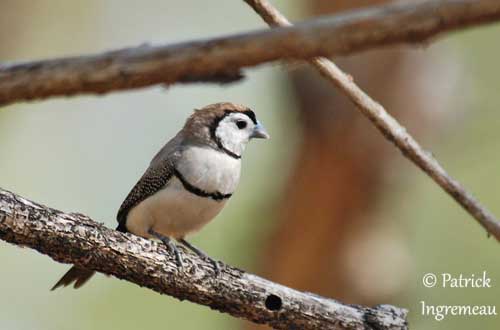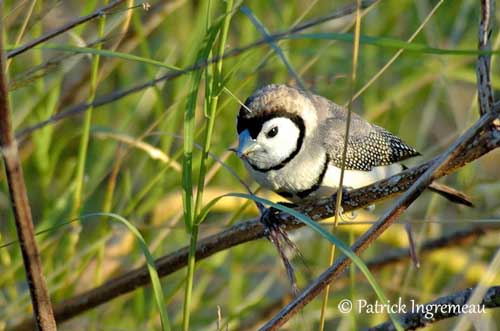
Fr: Diamant de Bichenov
All : Ringelastrild
Esp: Pinzón de Dos Barras
Ital : Diamante di Bichenow
Nd: Bichenow-astrild
Sd: Ringastrild
Photographers:
Jean Michel Fenerole
Photos d’Oiseaux du monde
Patrick Ingremeau
TAMANDUA
Text by Nicole Bouglouan
Sources:
HANDBOOK OF THE BIRDS OF THE WORLD Vol 15 by Josep del Hoyo-Andrew Elliot-David Christie - Lynx Edicions – ISBN: 9788496553682
L’ENCYCLOPEDIE MONDIALE DES OISEAUX - Dr Christopher M. Perrins - BORDAS - ISBN: 2040185607
BirdLife International (BirdLife International)
Birds in backyards (Birds Australia and Australian Museum)
Double-barred Finch
Taeniopygia bichenovii
Passeriforme Order – Estrildidae Family
BIOMETRICS:
Length: 10-11 cm
Weight: 7-12 g
DESCRIPTION:
The Double-barred Finch is an Australian bird sometimes named Owl Finch, due to the conspicuous facial disks around the eyes, so typical of owls.
The adult of the nominate race has brown upperparts from crown to back, with weak blackish barring. Rump and uppertail-coverts are white but the tail is black. On the black upperwing, the wing-coverts and the inner flight feathers show white spots and bars.
The underparts are white overall, with some different wash according to the area. The throat is white, bordered with narrow black band. The breast is pale greyish with indistinct fine grey barring on both sides. There is a second narrow black band across the lower breast. Belly and flanks are whitish, but the undertail-coverts are black.
On the head, the forehead is black whereas the face is white. The black and white head pattern is similar to facial disks bordered with black.
The strong bill is pale bluish-grey. The eyes are dark brown. Legs and feet are grey.

Both sexes are almost similar, but the male has thicker chest bars and brighter white face and breast.
The juvenile has the same pattern, but its plumage is browner, with brown forehead, buffish-brown upperparts, brown wings with whitish spots and bars, brownish bars (around face and across lower breast) and blackish bill.
We can find two subspecies:
T.b. bichenovii (here described) is found in E Northern Territory (coastal region), N and E Queensland, New South Wales and N Victoria.
T.b. annulosa occurs in N Western Australia and N Northern Territory. This one is almost similar to nominate, but it has black lower back, rump and uppertail-coverts.
VOICE: SOUNDS BY XENO-CANTO
The Double-barred Finch utters a short, nasal “tat tat” as close contact call, and a drawn out “tzeeaat” or a plaintive “twoooo-twoooo” when the birds are more scattered.
The female’s voice is lower pitched.
The song is a soft, repetitive series of buzzy contact calls and trills.
HABITAT:
The Double-barred Finch is never far from water. It frequents open woodlands and forest edges, grassy woodlands, scrublands, farmlands, roadsides, parks and gardens. It can be seen in the vegetation along the streams.
RANGE:
See above in “subspecies”.
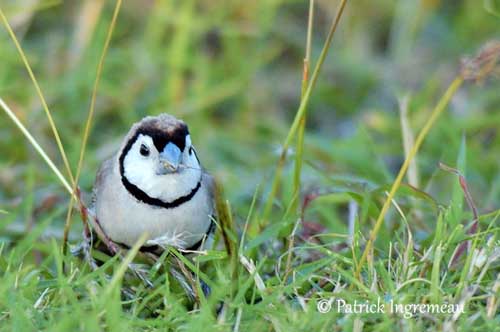
BEHAVIOUR:
The Double-barred Finch feeds on seeds from grass, but during the breeding period, it takes sometimes insects, adults and larvae. The seeds are taken from the ground or by jumping up to reach the seeds from the stem heads.
It usually forages alone or in pairs, but also in groups of 12-14 birds, but sometimes up to 50 or more. It may be seen in mixed flocks with other finches.
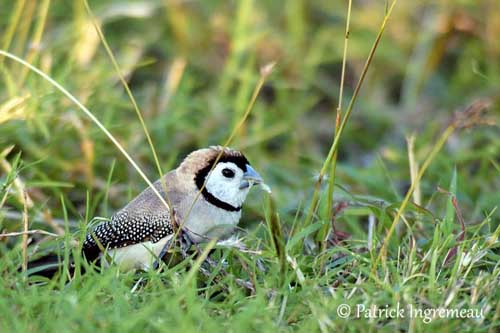
During the breeding season, the male may perform some displays. It hops towards the female with fluffed plumage except on the upperparts. It moves its body from side to side while singing.
The “stem display” occurs only occasionally in this genus. During this display, the male holds a grass stem in the bill.
Another display shows the male with ruffled feathers, leaning forwards and turning the head towards the female. It rubs its bill against the perch several times. This behaviour is accompanied with a very soft chatter.
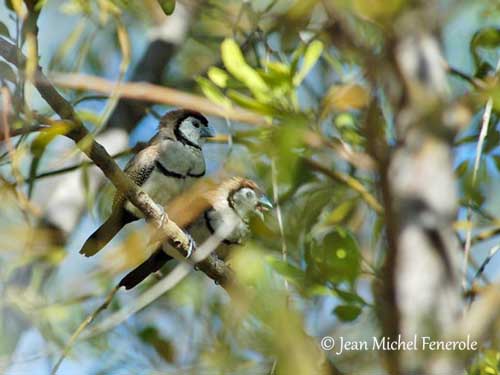
The Double-barred Finch is resident in its range. Some post breeding movements may occur N along the E Australian coast, and according to the dry periods and the rainfalls in N Australia.
FLIGHT:
The Double-barred Finch has bouncing, undulating flight pattern.
REPRODUCTION:
The breeding season may vary according to the range, but usually takes place in the second half of the wet season in N Australia, all year round in Queensland, and between July and November/December in New South Wales.
The Double-barred Finch builds a ball-shaped nest with a side entrance, and occasionally a short tunnel leading to the nest chamber which is lined with soft grasses, feathers or plant down. The nest is made with grass.
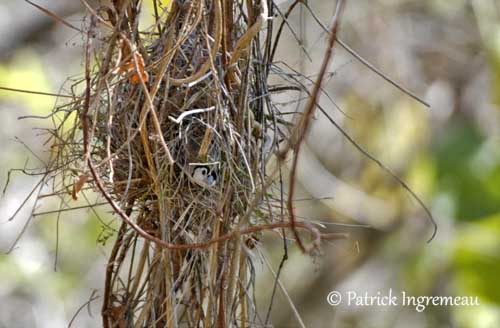
It is placed between 1 and 5 metres above the ground in bush, small tree, or in tree-hole. It is often situated close to an active wasps’ nest. An old nest may sometimes be reused. They repair and reline this nest with fresh grasses.
The female lays 3-6 white eggs. Both adults share the incubation during 11-13 days. The young birds fledge about 19 days after hatching. They still depend on parents for 2-3 weeks more.
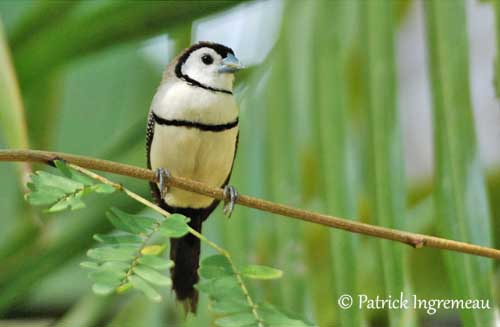
DIET:
The Double-barred Finch feeds primarily on seeds from several grasses and herbs. It may occasionally take insects and their larvae during the breeding season.
This species feeds mainly on the ground, sometimes jumping up to reach the seeds on the stem.
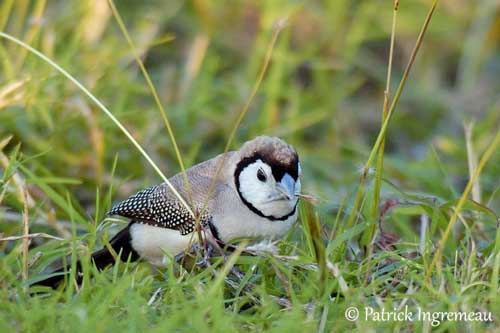
PROTECTION / THREATS / STATUS:
The Double-barred Finch can be common or locally common.
It is often kept as a cagebird.
This species is not currently threatened, in spite of some declines in the eastern coastal regions.
